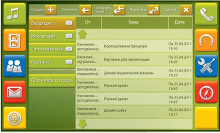In-car media server hobnobs with Android, Linux devices
Jun 14, 2011 — by Eric Brown — from the LinuxDevices Archive — 47 viewsLuxoft and Elektrobit Corp. (EB) announced a jointly developed, Linux-based reference platform for a DLNA-ready in-car media server, and also demonstrated Luxoft's Linux-based DashCore and Android-based DroidBuzz IVI software. The “wallet sized” In-Car Media Server and Internet Hotspot is based on a 456MHz ARM9 processor, and offers 64MB SDRAM and 128MB flash, plus Ethernet, USB, Wi-Fi, Bluetooth, GPS, and 3G connectivity, says Luxoft.
Typically, in-vehicle infotainment (IVI) devices combine a computer with a touchscreen in a single device, but Russian IT software and services firm Luxoft and Finnish device maker Elektrobit (EB) have designed their IVI design as a display-free media server device. The design takes into the account the multiple seatback displays in the latest automotive designs, as well as the increase in mobile wireless media devices that passengers bring with them.
The in-car server not only streams media to these devices but can accept uploads from a device to share with others. In addition, it acts as a Wi-Fi hotspot for in-car devices, says Luxoft, a member of the IBS Group.

Luxoft/EB In-Car Media Server and Internet Hotspot prototype
(Click to enlarge)
The in-car server is further equipped with 64MB of RAM, 128MB flash, and a microSD slot, says Luxoft. Ethernet and USB 2.0 host and device ports are available, while USB On-the-Go is optional, says the company.
Wireless features include GSM/GPRS/WCDMA 2G/3G cellular connectivity, Bluetooth 2.1, and 802.11b/g Wi-Fi, as well as the Wi-Fi hotspot capability, says Luxoft. A mobile TV module is said to be optional, offering DVB-T, DVB-H, and DVB-SH support, among other standards. The device is powered by a car's 12V socket, says Luxoft, which notes that detail might change for the final release.
Luxoft's client software is said to interact with the vehicle's head unit, rear seat entertainment systems, and mobile devices. In addition, the in-car media server can transmit media to "almost any device with a web browser and Wi-Fi," as well as a UPnP/DLNA client. These include Android- and Linux-based devices, as well as Apple iOS devices such as the iPad, says the company.
The software is said to sync digital content with external media storage via USB or Wi-Fi. Digital rights management (DRM) is said to be optional.
EB claimed to have designed the world's first MID (mobile Internet device) reference device in 2007. The company then demonstrated a cellular-voice-enabled MID design in 2009 that ran Moblin Linux on Intel's "Moorestown" version of the Intel Atom (eventually known as the Z6xx). The design never saw the light of day, however, as Moblin turned to MeeGo, and then Nokia turned away from MeeGo to Microsoft.
Luxoft's DashCore and DroidBuzz
Luxoft showed off the EB-built design at the Telematics Detroit 2011 shows last week, where it also demonstrated a Genivi-compatible Linux IVI stack called DashCore and an Android-based IVI stack called DroidBuzz.
At least two other Linux-based IVI designs based on the Genivi Alliance's open source Linux automotive middleware standard were also demonstrated at the show. A MontaVista/Rightware Oy reference platform integrates Rightware's Kanzi UI Solution with MontaVista Linux, and Renesas Electronics's ARM-Cortex-based "R-Car" platform incorporates CSR's SiRFstarIV-based GPS technology.
It does not appear that DashCore is part of the EB reference design, as the company made no mention of Genivi or DashCore in its in-car server announcement. With its GLONASS satellite connectivity support, DashCore appears to be aimed primarily at the Russian and Eastern European market, where Luxoft claims to have a major presence.


Luxoft DashCore (left) and DroidBuzz
(Click on either to enlarge)
Luxoft also demonstrated DroidBuzz, claimed to be the world's first Android-based IVI software platform developed specifically for rear-seat entertainment systems. Based on Android 2.2, the ARM-compatible software is said to provide a tablet computer-like experience allowing passengers to surf the web, use social media networks, and download content.
Stated Michael Minkevich, VP Technology Services, Luxoft, "The market for in-vehicle infotainment systems is experiencing a phenomenal growth. The multitude of devices, applications and standards, however, presents a challenge to users. How do you make all those disparate devices work together and speak the same language?"
Availability
Luxoft did not say when the EB reference design for In-Car Media Server and Internet Hotspot will be available. More information may eventually appear at Luxoft's IVI page. More on its IVI software stacks may be found at its DashCore page and DroidBuzz page, respectively.
This article was originally published on LinuxDevices.com and has been donated to the open source community by QuinStreet Inc. Please visit LinuxToday.com for up-to-date news and articles about Linux and open source.